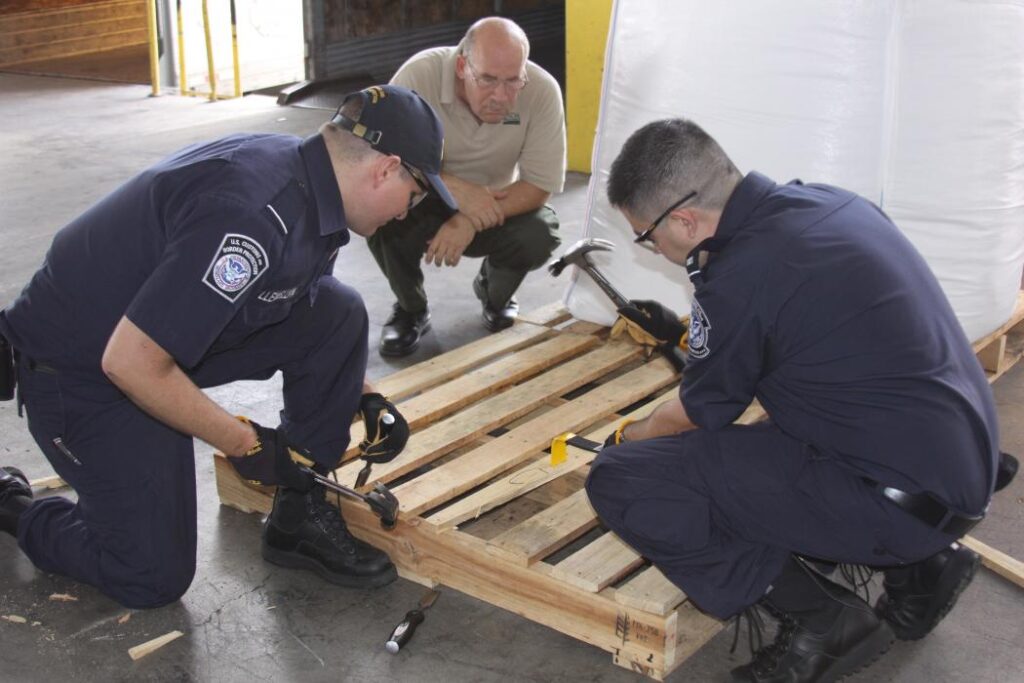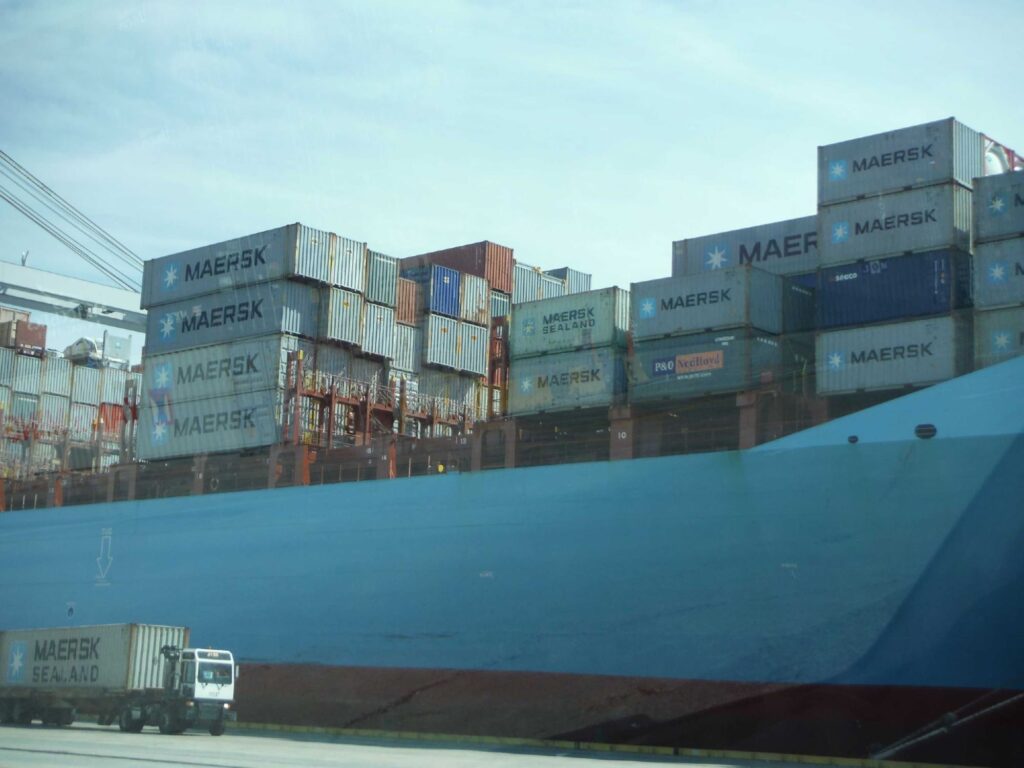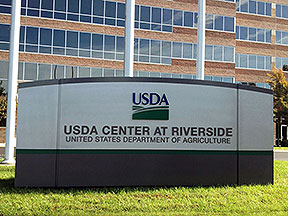Wood packaging – crates, pallets, spools for wire, etc. — has been recognized as a major pathway for introduction of tree-killing pests since the Asian longhorned beetle was detected in New York and Chicago in the late 1990s. As of 2021, 65 new species of non-native wood- or bark-boring Scolytinae had been detected in the United States (Rabaglia; full citation at end of the blog).
As I have often reported [To see my 40+ earlier blogs about wood packaging material, scroll down below archives to “Categories,” click on “wood packaging”.], the international phytosanitary community adopted the International Standard for Phytosanitary Measures (ISPM) #15. The goal of ISPM#15 is to “significantly reduce” [not eliminate] the risk of pests associated with solid wood used for constructing packaging (e.g., crates, pallets), from being introduced to other countries through international trade.
I recently reviewed the first 20+ years of implementation of ISPM#15 including two analyses by Robert Haack and colleagues in a blog in December 2022. I have also provided the broader context of the World Trade Organization (WTO) in my Fading Forests II report.
I last blogged about U.S. import volumes in June. My silence since reflected the significant decline in U.S. imports from Asia. This reduction had reduced the likelihood that a new tree-killing pest would be introduced from that region – or that an already-established pest would be introduced to a U.S. region that had escaped it so far.
However, U.S. imports from Asia have suddenly grown! In October 2023, containerized imports from Asia were 12.4% higher than a year ago – and 6% higher than in September. According to the Journal of Commerce (full citation at end of blog), U.S. retailers anticipate consumers will purchase lots of gifts for the upcoming Christmas season.
The U.S. imported 1.57 million TEU from Asia in October. This volume exceeded even the pre-COVID levels. How great is the associated risk of a pest introduction? To calculate that, I apply the following:
- most U.S. imports arrive in 40-foot-long containers, so divide TEU by 2 = 785,000
- a decade-old estimate that 75% of containers in maritime shipments contain wood packaging (Meissner et al.) = 588,750 containers with wood packaging (I suspect it is more).
- the estimate by Haack et al. 2014 that 0.1% (1/10th of 1 percent) of consignments (which usually means a single container) harbor tree-killing pests;
- the estimate by Haack et al. 2022 that 0.22% of consignments harbor tree-killing pests.

The result of these calculations is an estimate of 648 containers (using the 2009 global estimate), or 1,727 containers (using the 2022 global estimate), or 5,730 containers (using the 2010-2020 estimate for China specifically) entering the country in one month harbored tree-killing pests. Since West Coast ports received 54% of those containers, the estimated number of containers transporting pests that enter California, Washington, or Oregon ranged from 349 to 3,042. The rest are scattered among the dozens of ports on the East and Gulf coasts.
With drought limiting container ship transits through the Panama Canal (Szakonyi 2023), the threat to East and Gulf coast ports might not rise commensurately.
Because of the low levels of imports in previous months, U.S. imports from Asia remain significantly below levels in previous years: 16.6% lower for the January – September period compared to 2022.
The 2022 analysis found that the rate of wood packaging from China that is infested has remained relatively steady since 2003: 1.26% during 2003–2004, and ranged from 0.58 to 1.11% during the next three time periods analyzed. Packaging from China made up 4.6% of all shipments inspected, but 22% of the 180 consignments with infested wood packaging. Thus the proportion of Chinese consignments with infested wood is five times greater than would be expected based on their proportion of imports. Note the great impact of this high infestation rate on the number of containers transporting tree-killing pests to the U.S. in the paragraph above: more than 8,000 containers compared to about 2,000.
I remind you that the U.S. and Canada have required treatment of wood packaging from China since December 1998. Why are the responsible agencies in the United States not taking action to correct this problem? [which has persisted for 2 decades]
The fact is – as I have argued numerous times — a pallet or crate bearing the ISPM#15 mark has not proved to be a reliable indicator as to whether the wood is pest-free. (This might be because the wood had not been treated, or if it was, the treatment failed). All the pests detected in the Haack et al. studies (after 2006) were in wood packaging bearing the ISPM#15 mark. As noted in my past blogs [click on the “wood packaging” category to bring up blogs about wood packaging and enforcement], Customs and Border Protection also report that nearly all the wood packaging in which that they detected insect pests bore the ISPM#15 mark.
According to Angell in November (full citation at end of blog), U.S. imports from India to the east coast fell by 15% in the first 10 months of 2023 compared to last year – to a total of 623,356 TEUs. This might change in the future: a shipper has promised to start weekly arrivals from India beginning in May 2024. the company plans calls at New York-New Jersey, Savannah, Jacksonville, Charleston, and Norfolk. The ships will call, en route, at ports in Saudi Arabia, Egypt, and Spain. What pests might be hitching a ride on these shipments?
SOURCES
Haack RA, Britton KO, Brockerhoff EG, Cavey JF, Garrett LJ, et al. 2014. Effectiveness of the International Phytosanitary Standard ISPM No. 15 on reducing wood borer infestation rates in wood packaging material entering the United States. PLoS ONE 9(5): e96611. doi:10.1371/journal.pone.0096611
Haack RA, Hardin JA, Caton BP and Petrice TR. 2022. Wood borer detection rates on wood packaging materials entering the United States during different phases of ISPM#15 implementation and regulatory changes. Frontiers in Forests and Global Change 5:1069117. doi: 10.3389/ffgc.2022.1069117
Meissner, H., A. Lemay, C. Bertone, K. Schwartzburg, L. Ferguson, L. Newton. 2009. Evaluation of pathways for exotic plant pest movement into and within the greater Caribbean Region.
Mongelluzzo, B. 2023. U.S. imports from Asia hit 2023 high in October despite muted peak season. Journal of Commerce https://www.joc.com/article/us-imports-asia-hit-2023-high-october-despite-muted-peak-season_20231116.html (access limited to subscribers, unfortunately)
Angell, M. 2023. ONE readies India-US East Coast service as part of 2024 network rollout. Journal of Commerce. November 27, 2023
Rabaglia, R. 2021. The increasing number of non-native bark and ambrosia beetles in North America. International Union of Forest Research Organizations. Prague, Czech Republic. September 2021
Szakonyi, M. 2023. Carriers Weigh Options as Panama Canal restrictions become fact of life. Journal of Commerce. November 21, 2023. (Access limited to subscribers, unfortunately)
Posted by Faith Campbell
We welcome comments that supplement or correct factual information, suggest new approaches, or promote thoughtful consideration. We post comments that disagree with us — but not those we judge to be not civil or inflammatory.
For a detailed discussion of the policies and practices that have allowed these pests to enter and spread – and that do not promote effective restoration strategies – review the Fading Forests report at http://treeimprovement.utk.edu/FadingForests.htm
or

